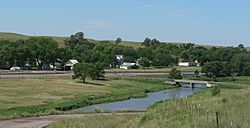Seneca, Nebraska facts for kids
Quick facts for kids
Seneca, Nebraska
|
|
|---|---|

Seneca seen from the southeast, across the Middle Loup River
|
|

Location of Seneca, Nebraska
|
|
| Country | United States |
| State | Nebraska |
| County | Thomas |
| Area | |
| • Total | 0.29 sq mi (0.76 km2) |
| • Land | 0.29 sq mi (0.76 km2) |
| • Water | 0.00 sq mi (0.00 km2) |
| Elevation | 2,969 ft (905 m) |
| Population
(2020)
|
|
| • Total | 49 |
| • Density | 166.10/sq mi (64.09/km2) |
| Time zone | UTC-6 (Central (CST)) |
| • Summer (DST) | UTC-5 (CDT) |
| ZIP code |
69161
|
| Area code(s) | 308 |
| FIPS code | 31-44385 |
| GNIS feature ID | 2784110 |
Seneca is a small, unincorporated community in Thomas County, Nebraska, located in the Great Plains of the United States. An unincorporated community means it's a group of homes and businesses that isn't officially a town or city with its own local government.
Seneca was first settled in 1888 when the Chicago, Burlington and Quincy Railroad was built through the area. For many years, it was the biggest settlement in Thomas County because of the railroad. However, when the railroad moved its operations, the population of Seneca started to shrink. In 2014, the people living there voted to officially dissolve the village.
Contents
History of Seneca
How Seneca Began
The Chicago, Burlington and Quincy Railroad was being built along the Middle Loup River in the late 1880s. Construction stopped for the winter of 1887–88 in western Thomas County. The community of Seneca was then started at this spot in January 1888.
Railroad's Impact on Growth
Seneca became an important division point for the railroad. This meant it had a train station, a rail yard, and a roundhouse. A roundhouse is a building where trains are stored and repaired. Over 70 people worked for the railroad in Seneca.
The railroad jobs brought money and helped the town grow. Between 1918 and 1923, a road called the Potash Highway was built. It ran from Grand Island to Alliance and went right through Seneca. The town had many shops, including hotels, banks, a lumberyard, and even a car dealership. For a while, Seneca was the largest town in Thomas County. Its population reached its highest point of 476 people in 1920.
Changes and Decline
In 1926, the Potash Highway became Nebraska Highway 2. In the early 1940s, the highway was moved south of Seneca to avoid many railroad crossings. The railroad also moved its operations out of Seneca. This meant many jobs were lost, and people started to move away. Many businesses in the town closed down.
Becoming Unincorporated
Around 2013, a disagreement happened about a rule the village board made. This rule said people could not keep horses in the town. This led to a request to dissolve Seneca as an official village. In May 2014, the residents voted 17 to 16 to disincorporate. The village was officially dissolved by the Thomas County Board at the end of June 2014.
Population Changes in Seneca
Seneca's population has changed a lot over the years. It grew when the railroad was important and then decreased as the railroad moved away.
| Historical population | |||
|---|---|---|---|
| Census | Pop. | %± | |
| 1920 | 476 | — | |
| 1930 | 272 | −42.9% | |
| 1940 | 255 | −6.2% | |
| 1950 | 219 | −14.1% | |
| 1960 | 160 | −26.9% | |
| 1970 | 111 | −30.6% | |
| 1980 | 90 | −18.9% | |
| 1990 | 78 | −13.3% | |
| 2000 | 51 | −34.6% | |
| 2010 | 33 | −35.3% | |
| 2020 | 49 | 48.5% | |
| U.S. Decennial Census | |||
Seneca's Population in 2010
According to the census from 2010, there were 33 people living in Seneca. These people lived in 21 households, and 10 of these were families. The population density was about 254 people per square mile. All the residents were White.
Out of the 21 households, two had children under 18 years old. Eight households were married couples living together. One household had a female head of household with no husband. Another had a male head of household with no wife. Eleven households were non-families. Eight households had someone living alone who was 65 years or older.
The average age of people in Seneca was 55.3 years. Three residents were under 18. One person was between 18 and 24. Four people were between 25 and 44. Fifteen were from 45 to 64, and ten were 65 or older. About 45.5% of the population was male, and 54.5% was female.
Images for kids
See also
 In Spanish: Seneca (Nebraska) para niños
In Spanish: Seneca (Nebraska) para niños



